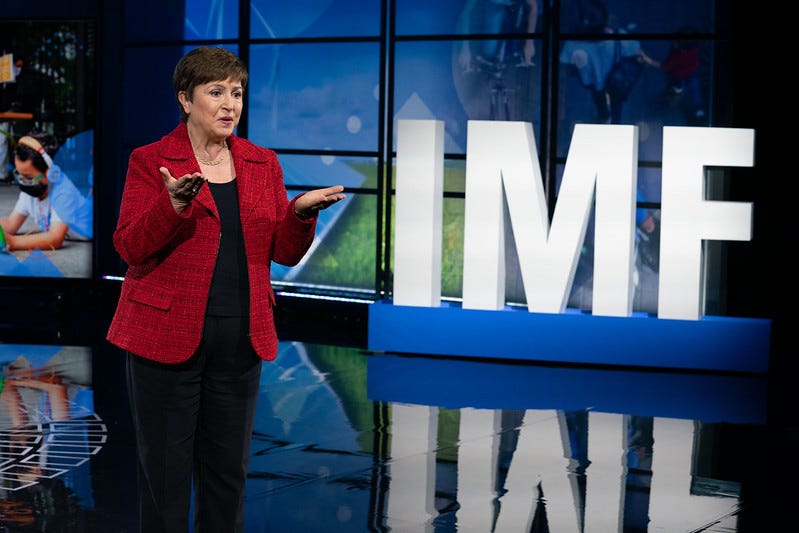IMF/World Bank austerity takes a hypocrite turn
Even while rich countries spend, poor countries struggle to pay
Welcome to a special edition of contention. This should take just about five minutes to read. Please take a moment to share with anybody you know that might like this analysis too!
The IMF and World Bank met last week for their spring meetings with the global economy in the midst of an historic recovery. In January, the IMF estimated that global GDP would gain 5.5% this year. Last week, they revised their estimate upwards to 6%.
But like all economic data, the picture gets much rosier the more money you have. The bottom line for last week’s meetings: the IMF and World Bank continue to ensure that rich countries can profit off of mass global suffering.
Top line estimates for intermediate-term growth highlight the disparity. Heading into the meeting, the IMF estimated that low-income countries will lose 5.7% annual per capita GDP off of pre-pandemic growth trends. Advanced economies -- on the other hand -- will fare much better, losing only 2.3% off their earlier trajectory.
Poor countries have already paid the price for these losses. Last year, the number of global poor -- counted as those who live on less than $2 per day -- rose by 131 million people to 803 million worldwide. The surge in poverty hit South Asia and sub-Saharan Africa hardest. The IMF warned the crisis would reverse up to a decade of the world’s “extreme poverty” reduction. This number would likely have been much higher were it not for China avoiding an economic contraction in 2020.
The IMF, for its part, did finally agree at last week’s meeting to allocate $650 billion in special drawing rights (SDR) monetary reserves this summer. SDRs are a form of liquidity for low- and middle-income central banks, and the allocation will give a cash injection to poorer countries looking to refinance their debts. But the amount authorized fell well short of the $3 trillion civil society organizations say these countries need to respond to the pandemic.
“In this context, the IMF and World Bank -- and their wealthy shareholders -- once again failed to take the decisive action required to ensure a just and inclusive recovery,” the Bretton Wood Project noted.
The SDR number is especially stingy in light of soaring debt pressure on Global South governments. The G20 has refused to cancel any poor-country debts, only kicking the due dates down the road by extending the Debt Service Suspension Initiative (DSSI) through the end of 2021.
Developing country debt was already on the rise before the pandemic, with DSSI-eligible country external debt climbing 9.5% in 2019 to a record $744 billion, more than doubling over the last decade. The IMF estimates poor countries will need up to $550 billion just to recover from the pandemic. Neither the World Bank nor the IMF have cancelled any debts since the pandemic, providing only $11.6 billion in assistance for poor countries in 2020 and $5 billion in debt-service relief for countries eligible for the DSSI.
And not only is the debt increasing in size, it’s becoming more and more painful for these countries to carry. Economic recovery in the U.S. and Europe is already bringing up a potential rise in interest rates, raising borrowing costs for debtor countries. The rate moves also strengthen the dollar -- i.e. they make dollars more expensive for everybody, effectively increasing poor countries’ debt.
What’s driving the recovery in rich countries? The very sort of state-driven economic policies the IMF and World Bank would never tolerate from lower income governments. In the U.S., the White House has announced a $2.25 trillion “infrastructure plan” that amounts to a new industrial policy for the country. The Wall Street Journal marked the bill as the end of “neoliberalism.”
At the same time, the United Kingdom has renationalized railways even under a Conservative government, reversing one of the legacies of Tory icon Margaret Thatcher. The European Union has also unrolled substantial fiscal packages to assist its recovery from the pandemic.
The World Bank, IMF and G20 group of creditors have encouraged these recovery packages. Economies must seek “opportunities and solutions that achieve sustainable and broad-based economic growth without harming the climate, degrading the environment, or leaving hundreds of millions of families in poverty,” World Bank President David Malpass said in a speech to the London School of Economics before the meetings.
But the IMF and World Bank continue to demand “neoliberal” austerity as conditions for their loans. Out of 91 IMF loans given out to 81 countries since March 2020, 76 required austerity measures such as raising regressive taxes on consumption and cuts to public expenditures including healthcare and pension plans, according to Oxfam.
“Fiscal consolidation,” removal of capital controls, price liberalization are their solutions to emerging market debt, the precise opposite of what rich countries are now pursuing.
“This regime would entail a fiscal stimulus undertaken by governments in advanced countries for the recovery of their respective economies from crisis,” Indian economist Prabhat Patnaik wrote, “but for the Third World countries there would be continued austerity, so that they continue to be afflicted by massive unemployment and income compression which also has the ‘advantage’ of ensuring that the recovery in the advanced countries is not constrained by the emergence of inflation.”
The IMF and World Bank will meet again in the fall, but if past experience suggests anything, it’s that nothing fundamentally will change before then. The rich will get richer faster than any other time in recent decades, while the poor continue to suffer their worst blow in a generation. These facts are connected, even if the institutions prefer to pretend otherwise.
Our only investment advice: Watch out for pirates.
Contact us with any feedback, questions, or stories we might have missed.




